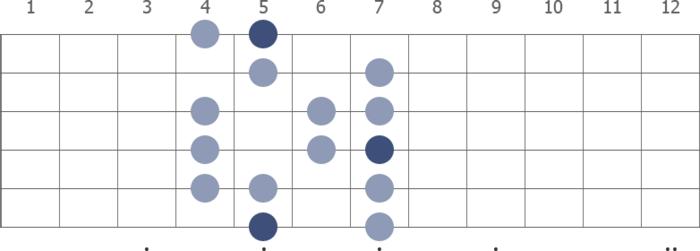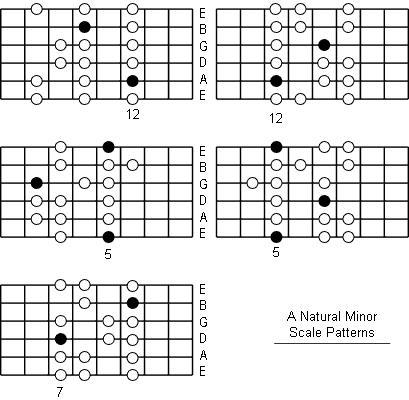Ever found yourself unable to decipher those intricate patterns and lines on guitar scale diagrams, wondering how simple markings can produce such divine melodies? Take a deep breath, because you’re about to unlock the magic. I remember when I first discovered the language of guitar scales. I felt like a cryptographer uncovering ancient text, the secrets of beautiful solos and complex riffs suddenly within my grasp – but we’ll leave the details of that adventure for later.
As a seasoned guitar journalist and educator, I’ve spent countless hours immersed in this fascinating world, peeling back the veil to revel in the beauty and complexity of guitar scales. I’ve come to understand how to read, interpret, and most importantly, apply them to enrich my playing. Now, it’s time for me to pass that knowledge on to help you learn guitar scales too. Start your journey, and let’s dive into this comprehensive guide.
Understanding Guitar Scales
Major Scales

Understanding major scales on the guitar is crucial to becoming a proficient player. After all, major scales guitar playing is a fundamental aspect of this instrument, forming the basis for many chords and melodies. Through my journey as a musician, I’ve found these scales especially meaningful and transformative to my guitar playing.
In essence, a major scale consists of seven distinct notes, with the eighth duplicating the first at double its frequency – this is commonly referred to as the “octave.” If you know where the root notes on the guitar are, you can play a major scale starting from any note. The pattern and intervals between the notes remain consistent – the only difference is the root note you begin with.
Your knowledge of major scales not only enables you to express emotions in a rich and varied manner but also provides a roadmap for improvisation and adds depth to your understanding of music theory. From my personal experience and expertise, I can assure you, delving into these major scales is a worthwhile endeavor, providing a solid foundation for your journey to guitar mastery.
Remember, the beauty of guitar lies in its versatility and ability to communicate. And major scales, they are a significant part of that conversation. Knowing them, truly understanding them, defines who you are as a guitarist.
Minor Scales

Emerging from the kaleidoscope of guitar scales, I can testify to the compelling allure of minor scales. Their dark, somewhat melancholy mood is integral to many musical styles and a necessary part of your guitar scale repertoire. When we venture into the domain of minor scales guitar, we’re essentially deepening our musical vocabulary, lending our riffs and solos more emotional depth and expressiveness.
The versatility of minor scales brings a distinct flavor to music. Understanding and mastering them allows you to navigate the fretboard with greater ease and adaptability. Every different minor scale shape you learn further expands your potential to improvise across a multitude of genres and moods.
Over the years, I’ve used these guitar scale shapes to weave spellbinding narratives with my music, and I believe you hold the same potential. Comprehending the patterns that underpin minor scales guitar is key to grasping their essence. Once familiarised, these shapes become your stalwart allies, empowering you to express on your guitar with eloquence and sensitivity.
Indeed, the exploration of minor scales is an enriching chapter in the broader saga of understanding guitar scales; an expedition that offers myriad benefits and profound insights.
Reading Guitar Scale Diagrams
Understanding Fretboard Diagrams

After understanding guitar scales, it’s time to shift focus to the core of our discussion, a crucial catalyst in mastering scales – fretboard diagrams. As a seasoned musician, I cannot emphasize enough the significance of these visual guides, which display the exact positioning of notes on the guitar.
Fretboard diagrams are undeniably instrumental in learning complex scales. Each horizontal line represents a string, and vertical lines signify frets. The dots illustrate where to place your fingers on the strings to play specific notes on guitar. Comprehending these diagrams simplifies the otherwise daunting task of figuring out the guitar’s fretboard, acting as a musical map that points you to your desired scales.
An intimate knowledge of the fretboard is an underpinning of technical proficiency and creative flexibility. Fretboard diagrams open the door to that understanding, connecting theoretical knowledge to physical application. Growing comfortable with these visual tools fast-tracks your journey towards creating melodies and solos with ease.
Now as you’ve understood the anatomy of the fretboard, we can delve deeper into the broader scope of reading guitar scale diagrams and how these central dynamics coexist within guitar theory. Remember, each piece of this puzzle works together to form the overarching picture of guitar scales proficiency.
Interpreting Guitar Scale Charts

Delving deeper into Reading Guitar Scale Diagrams, the paramount significance of understanding how to interpret guitar scale charts becomes evident. The power of these tools lies in their capacity to help visualize and master scale positions on a guitar, taking your playing skills to a whole new level. Leveraging my professional expertise as an engraver amd instructor, here are some of my practical insights on interpreting these charts.
Guitar scale charts, as I found through uncountable encounters and applications, provide a vivid representation of scale positions on the guitar, connecting theory to practical usage. Visualizing this demonstrated marked improvements in interpreting melodies, improvising solos, and composing original music.
Typically, the chart features a grid portraying a section of the guitar neck, where horizontal lines represent frets, and vertical lines depict strings. The marked points display where to position your fingers. Keep in mind, these charts don’t guide you on which fingers to use, instead, they highlight where to press on the fretboard for scale positions.
It’s essential to approach these charts with an understanding of the fretboard. As the notes ascend on the chart, they correspondingly elevate in pitch on the guitar. To recall this easily, think of climbing a ladder- as you climb up, you also rise higher. Fundamentally, interpreting guitar scale charts involves understanding this verticality.
If you wish to pattern your style after any renowned guitarist, you’ll likely find a scale chart depicting their preferred positions. These charts, while they might initially seem cryptic, are rich with unveiling stylistic nuances. As you consistently decode these, you make strides in expressing your musical voice on the guitar.
Interpreting Guitar Scale Charts underscores not just reading diagrams, but really shaping your command over scales. It’s akin to having a roadmap that confers creative freedom, allowing you to form sounds, sequences, and stories in unique ways. Stay tuned for the next section where we explore this practical engagement- Applying Guitar Scales.
Applying Guitar Scales

Practical application of guitar scales has been central to my musical journey. Through my performances and guitar lessons, I’ve learned how to use scales effectively, a skill I’m eager to share with you. My experience and understanding have deepened my appreciation for how guitar scale practice can truly unlock your potential as a music enthusiast. Applying guitar scales has transformed my own guitar-playing skills, opening up new realms of creativity and improvisation.
A pivotal aspect of this journey has been learning how to interpret and apply guitar fretboard patterns. Recognizing these patterns and their relevance to scale configurations has allowed me to navigate the fretboard with more fluency and proficiency. Although it does require concerted effort and dedication, the payoff is irreplaceable; it is what makes you a rounded, dynamic, and versatile guitarist.
Are you eager to play that solo you admire? Harnessing the power of guitar scales can make it possible! Understanding and applying guitar scales not only brings precision to your performance but also adds depth to your musical interpretation. The more conversant you are with various scale patterns and how to apply them, the easier it becomes to translate your musical ideas and inspirations onto the guitar.
A crucial aspect to remember is consistency in practice. It’s not about how many hours you practice in a day, but rather, the regularity and quality of your sessions. As you continue to explore different scales and their applications on the fretboard, guitar scales will become second nature, truly enriching your repertoire and enhancing your ability to express freely through your instrument.
Whether you’re embarking on your journey of mastering guitar scales or enhancing your existing skills, I hope my insights will help guide your exploration. In the next section, we’ll look into commonly asked questions about guitar scales and I will offer my insights from years of experience. Remember, the journey may seem long, but every note you strum in practice brings you one step closer to your goal.
FAQs
What are Guitar Scales?
How many types of guitar scales are there?
How to read guitar scale diagrams?
How to practice guitar scales?
Conclusion
At the crossroads of music and mathematics, does the journey through guitar scales enthrall you? It certainly has me. The exploration and comprehension of guitar scales have been both an enlightening and transformative journey for me. Whether it be the intricate major or stark minor scales, understanding fretboard diagrams or interpreting guitar scale charts, the knowledge gained has been truly enriching. As the final chords of this guide resonate, my hope is for my shared insights and experiences to empower you to learn guitar scales with confident fluency. Taking it a step further, let these scales guide your own musical compositions and improvisations. Remember, practice makes perfect. Good luck!
